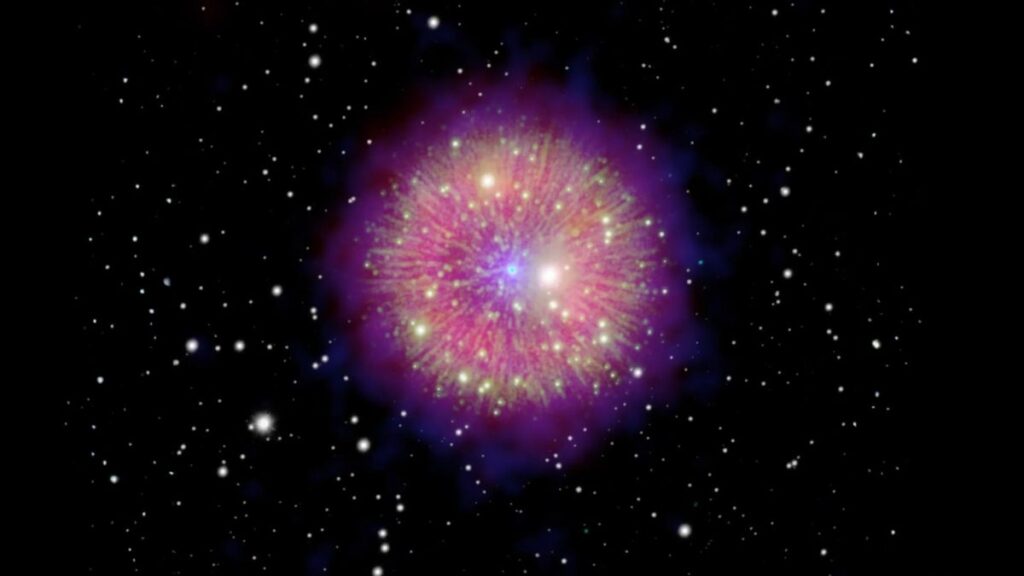Astronomers made an amazing discovery that shows a zombie star, survives a supernova explosion. A supernova, which occurred nearly 1,000,000 ago, has baffled scientists and raised many questions about the universe. This time, the zombie star is surrounded by the debris of the supernova that could offer information about the nature of supernovas.
A supernova explosion is catastrophic and typically marks the death of a star, which results in the complete destruction of a star. However, in the case of supernova SN 1181, the remnants included a ‘zombie star’ means a white dwarf star that survived the blast.
Historic Observation of SN 1181
SN 1181 is one of the rarest historical supernovas recorded before the invention of the telescope in the world. Some Chinese and Japanese astronomers first noted this supernova in 1181 AD, and they described it as a guest star that shone brightly in the sky for more than six months. It is one of the few supernovas documented in such detail, even before any modern scientific tools were available.
Nebula Pa 30 has the remnants of the SN 1181 supernova that is located within our Milky Way galaxy. It was identified by astronomer Dana Patchick in 2021. Astronomers analyzed the nebula properties, and they were able to date the explosion to roughly around 1000 years ago, which takes us to around in the year 1181 AD and confirms the ancient records of this supernova.
Typically, a supernova explosion completely destroys a white star. Still, in this case, the white dwarf survived and left behind a zombie star that continues to emit light and energy. This type of supernova is known as type Iax supernova, which is less destructive than the more common type Ia supernova.
Zombie Star Survives Supernova Explosion
The survival of this zombie star, means a white dark star at the heart of Supernova SN1181 has confused the astronomers. In a normal supernova, explosive forces are so strong that they completely destroy the star and leave behind a cloud of gas and dust. But in this supernova, the zombie star remains intact in its position, raising questions in the minds of astronomers.

To understand how the zombie star survives, first, it’s important to know the differences between type Ia and type Iax supernovas. At the same time, both types of supernovas are linked to white dwarf stars.
Type Ia Supernovas: this is a common type that results from the explosion of a white star that accumulates matter from a component star, and when it reaches its critical mass or thermonuclear explosion happens and destroys it completely.
Type Iax Supernovas: it is a rare glass which is only 5% of type a Events in which the explosion is less violent and leads to survival of white dwarf star as a ‘zombie star’.
Astronomers, led by Tim Cunningham from the Center for Astrophysics, Harvard & Smithsonian, and Ilaria Caiazzo from the Institute of Science and Technology Austria, used advanced 3D technology to study SN 1181. They applied the Keck Cosmic Web Imager (KCWI) to create a 3D model of the supernova remnant, providing essential data into its velocity and spatial structure.
KCWI is a powerful spectrograph located at the W.M. Keck Observatory on top of the Mauna Kea in Hawaii. This spectrograph has the capability to detect distant, faint sources of light from large structures in the universe. Astronomers captured the spectrum of light from the supernova and visualized the motion of the debris in SN 1181.
The discovery of the Zombi star challenges our understanding of Supernova and the life cycle of stars. It suggests that some white dwarfs can survive the exclusive death of their campaign and stars, which gives us new data into the diversity of stellar revolution.
Editor’s Recommendations
- Euclid Space Telescope Reveals the 1% of Universe Map From Great Cosmic Atlas
- Hubble Telescope Captures Breathtaking ‘Stellar Volcano’ Eruption
- 1st Triple Black Hole System Found by Chance, But It Challenges the Coventional Black Hole Formation Theories
- Universe Shakedown: What Really Happens When Black Holes Merge?




